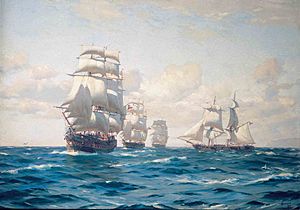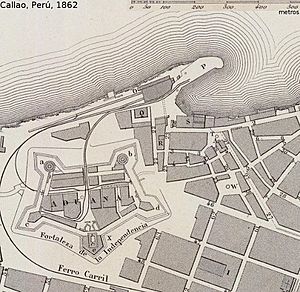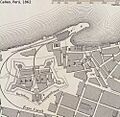First Chilean Navy Squadron facts for kids
Quick facts for kids First Chilean Navy Squadron |
|
|---|---|
| Primera Escuadra Nacional de Chile | |

Departure of the First Chilean Navy Squadron on 9 October 1818, Thomas Somerscales
|
|
| Active | 1817–1826 |
| Country | |
| Branch | |
| Type | Navy |
| Role | Naval warfare |
| Engagements | Spanish American wars of independence |
| Commanders | |
| Supreme commander | Bernardo O'Higgins Ramón Freire |
| Fleet commander | Manuel Encalada Thomas Cochrane |
| Insignia | |
| Identification symbol |
 |
The First Chilean Navy Squadron was a special group of ships that helped end Spanish rule in the Pacific Ocean. This navy played a huge role in the Latin American wars of independence. The government of Chile created this squadron to fight the Spanish in Peru. Peru was the main center of Spanish power in South America. By fighting there, Chile and Argentina could become truly independent.
Contents
The Napoleonic wars (1803–1815) had greatly weakened Spain's navy. Many of its ships were lost. Even so, during an early period called Patria Vieja (Old Fatherland), Spanish forces in Peru could block Chilean ports. They could also land troops in loyal ports like Talcahuano. This helped them fight against the Chilean revolutionaries in Santiago de Chile.
Before 1814, Chile's revolutionary forces had almost no navy. Two ships they bought were quickly defeated in 1813.
After the Battle of Chacabuco in 1817, Chilean patriots took back Santiago. This marked the start of the Patria Nueva (New Fatherland). However, some areas like Talcahuano, Valdivia, and Chiloé remained under Spanish control.
Chilean leaders realized they needed their own navy. A strong navy would protect Chile's long coastlines. It would also help move troops against the enemy. Without a navy, Chile was open to attacks from the sea.
How Other Countries Reacted
Britain and the United States were mostly concerned about trade. During the Napoleonic Wars, Britain supported Spain against France. In 1817, Britain even made a rule stopping its citizens from joining Spanish American armies. But in reality, this rule was not always followed strictly.
Still, many people in Britain and the U.S. liked the idea of South American countries becoming free. After the Napoleonic Wars, Britain reduced its navy. This meant fewer British warships were patrolling the coasts of South America.
Building the Squadron (1817-1818)
After the Battle of Chacabuco, Bernardo O'Higgins said that winning battles on land wasn't enough. He believed Chile needed to control the sea. So, on November 20, 1817, the Chilean government allowed private ships to attack Spanish trade. These privateers caused problems for Spanish ships.
However, these privateers sometimes attacked neutral ships too. They also hired sailors who had left the navy. O'Higgins eventually had to limit their actions.
O'Higgins wanted to build a navy from scratch. José Ignacio Zenteno became the Minister of Marine. He created rules for the new navy in November 1817. Agents were sent to London and New York City to find ships and sailors.
Chile's first ship was an old U.S. smuggler ship called Eagle. The Spanish had captured it, but now Chile had it. It was renamed Águila and later Pueyrredón. The Chilean navy grew quickly. They bought two large ships, Windham and Cumberland, from England. They renamed them Lautaro and San Martín. In July 1818, they bought a U.S. brig called Columbus and renamed it Araucano.
Rescuing Prisoners from Juan Fernández Island
The first important job for the ship Águila was to rescue 72 Chilean patriots. These patriots were prisoners on the Juan Fernández Islands. This rescue was very important. Many of the rescued people were leaders of the early revolutionary governments. They included Manuel de Salas, who helped ban Slavery in Chile, and Juan Egaña, who helped write Chile's first constitution.
Later, Águila and Lautaro worked together. They broke the Spanish blockade of Valparaíso by the ship Esmeralda.
Battles and Blockades (1818-1819)
After 1814, Spain's King Fernando VII wanted to keep his American colonies. In October 1817, Spain planned to send many soldiers to South America. But Spain was almost out of money and its government was unstable.
On May 21, 1818, eleven Spanish ships sailed from Cádiz. They were heading to Talcahuano, a port in Chile still held by Spain. These ships carried food, weapons, and over 2,000 soldiers. This was called the "Expedition of the South Sea."
During the trip, one Spanish transport ship had many sick crew members. Near the equator, the soldiers on board mutinied. They killed their officers and sailed to Buenos Aires. There, they surrendered to the Argentine revolutionaries. They also gave the Argentines important information about the Spanish expedition. Argentina quickly sent this information to Chile.
Capturing the Spanish Frigate María Isabel
On October 19, 1818, the first commander of the Chilean Squadron, Manuel Blanco Encalada, was ordered to stop the Spanish convoy. He sailed with the ships San Martín, Lautaro, Chacabuco, and Araucano. Later, Galvarino and Intrépido joined them.
On October 28, they found the Spanish frigate Reina María Isabel anchored in Talcahuano. The Spanish crew tried to damage their ship so the Chileans couldn't use it. But the Chileans quickly captured the frigate and repaired it. They then sailed to Santa María Island. One by one, several Spanish transport ships sailed right into their hands, not knowing what had happened. Only four Spanish transports managed to land soldiers in Talcahuano before continuing to Callao.
The Reina María Isabel was renamed O'Higgins and became part of the Chilean Squadron. With this loss, Spain lost control of the sea. This made an invasion of Peru by the revolutionaries a real threat.
Lord Cochrane and the Diverse Crew

In mid-1818, Bernardo O'Higgins hired Thomas Cochrane. Cochrane was a brave and successful British captain from the Napoleonic Wars. He was hired to command the new Chilean Navy. Cochrane arrived in Valparaíso in December 1818. He became a Chilean citizen and was made a vice admiral.
The First Chilean Squadron had a very mixed crew. There were two main groups: those who spoke English and those who spoke Spanish. It was decided that each ship would use the language of its commander.
When Lord Cochrane took command, about 500 British sailors and officers joined him. Cochrane didn't fully trust the Chilean officers. So, he replaced many of them with British or American officers. This meant that the First Chilean Squadron mostly used English. One British officer even said the uniforms looked very similar to theirs.
Cochrane was Chile's first vice admiral. He reorganized the navy, bringing in British naval traditions and making English the official language. By January 1819, the squadron was fully organized. About two-thirds of the sailors and almost all the officers were British or North American.
First Blockade of Callao
On January 14, 1819, the squadron, including O'Higgins, Lautaro, Chacabuco, and San Martín, sailed to Callao in Peru. Their main goal was to block the port of Callao and stop Spanish ships. A second group of ships followed in March.
The expedition freed 29 Chilean soldiers held on San Lorenzo Island. They also captured Spanish ships and valuable goods like money, gold, and silver. However, the strong forts at Callao and the Spanish ships' refusal to leave the port prevented a full victory. On June 1, the squadron returned to Valparaíso.
More Battles (1819-1820)
On May 11, 1819, the King of Spain sent a new expedition to America. It included two large ships, San Telmo and Alejandro I, a frigate called Prueba, and a transport ship Mariana. They sailed from Cádiz to Callao.
Second Blockade of Callao
On December 12, 1819, the Chilean squadron sailed again to attack Peru. Their goals were to control the Pacific Ocean, find and destroy the new Spanish ships, and attack Callao with rockets. They were also ordered not to harm Peruvian people or property. This expedition cost Chile a lot of money.
Cochrane found that the forts at Callao were even stronger. He realized that more attacks would likely fail. The expedition did not achieve all its goals.
However, the Spanish reinforcements sent from Cádiz had problems. The Alejandro I had to return to Spain because it was leaking. The San Telmo was lost in a bad storm near Cape Horn, with all 644 men. Only the transport Mariana and the frigate Prueba reached Callao. But the frigate Prueba fled to Guayaquil when the Chileans chased it.
Capturing Valdivia

After failing to capture the Spanish fort in Callao, Thomas Cochrane made a bold decision. Without telling the Chilean authorities, he decided to attack Valdivia. Valdivia was the strongest Spanish fort in southern Chile. It was a major base for Spanish troops and the first landing spot for ships coming from Spain. Valdivia also helped Spanish fighters in the Guerra a muerte (War to the Death) in the La Frontera area.
Valdivia was hard to reach by land because of Mapuche territory. The only way in was through the mouth of the Valdivia River, at Corral Bay. This bay had many forts built to stop attacks.
The forts of Valdivia were captured on February 3 and 4, 1820. This victory ended Spanish power in mainland Chile. Chile gained a lot of military supplies, including gunpowder, cannon shot, musket balls, and 128 pieces of artillery. The Chilean ship Intrépido was lost during this battle.
The Freedom Expedition to Peru (1820-1821)
Chile and Argentina were supposed to work together to free Peru. But Argentina was having internal problems and facing another threat from Spain. So, Argentina could not help. José de San Martín was ordered to return to Argentina, but he chose to disobey. O'Higgins then decided that Chile would pay for the expedition to Peru.
On August 20, 1820, the expedition sailed from Valparaíso. They headed for Paracas, near Pisco in Peru. The Chilean squadron provided the escort. It included the flagship O'Higgins, San Martín, Lautaro, Independencia, Galvarino, Araucano, Pueyrredón, and Moctezuma.

On September 8, 1820, the army landed in Peru. There were 4,118 soldiers, and 4,000 of them were Chileans.
On the night of November 5, Cochrane and 240 volunteers captured the Spanish frigate Esmeralda (1791) inside the port of Callao. This was a very daring raid. The ship was renamed Valdivia and joined the Chilean Navy.
Peru was not seen as enemy land, but as a country occupied by Spanish forces. The commander, José de San Martín, wanted to defeat the Spanish army so Peruvians could free themselves. He took a slow and careful approach.
Cochrane's Final Voyages (1821-1822)
In July 1821, the liberation troops entered Lima, the capital of Peru. They declared Peru's independence. San Martín was named Protector of the new state. However, Spanish troops still held strong in the highlands. Cochrane disagreed with San Martín's cautious approach.
San Martín promised to pay the fleet bonuses after Lima fell. But he refused to pay for the fleet's daily costs or prize money for the Esmeralda. He said these were Chile's responsibility. Cochrane was very angry. When the Peruvian treasury was loaded onto a ship to avoid the Spanish army, Cochrane seized the ship on September 14. He took the money, which was a large sum.
Now in a big conflict with San Martín, Cochrane sailed away on October 6, 1821. He took the Araucano, O'Higgins, Valdivia, Independencia, and Mercedes. He wanted to find the last remaining Spanish frigates, Venganza and Prueba. After a month in Guayaquil for repairs, the squadron searched the Pacific coast. They went as far north as Loreto, Baja California Sur. During this trip, the Araucano was lost to mutineers.
After chasing them for five months, Cochrane trapped the Spanish ships in the port of Guayaquil. They surrendered to the port authorities.
The O'Higgins and Valdivia returned to Valparaíso on June 2, 1822. Cochrane left the Chilean Navy on November 29, 1822.
Capturing Chiloé (1825)
In 1825, a squadron led by Manuel Blanco Encalada landed 2,575 troops on Chiloé. The island was then blocked by the navy. The Spanish forces on Chiloé were the last Spanish stronghold in South America. They surrendered on January 12, 1826.
End of the Squadron
In April 1826, Ramón Freire, who took over from O'Higgins, greatly reduced the navy. He kept only one brig active. He sold the O'Higgins and Chacabuco to Argentina.
What Happened Next
Chile's efforts to create and maintain the navy were very expensive. The country became poor. Even O'Higgins and his ministers were not paid for months. As a result of the Latin American wars of independence, U.S. President James Monroe declared the Monroe doctrine on December 2, 1823. This doctrine warned European powers not to interfere in the Americas.
See also
 In Spanish: Primera Escuadra Nacional de Chile para niños
In Spanish: Primera Escuadra Nacional de Chile para niños
- Chilean Navy
- List of decommissioned ships of the Chilean Navy
- Manuel Hipólito Orella
Images for kids
-
The fortress of Callao protected the Spanish ships.
-
A painting of the fall of Valdivia in the Chilean naval and maritime museum
-
Capture of the Esmeralda in the bay of Callao, L, Colet, Club Naval, Valparaíso.










